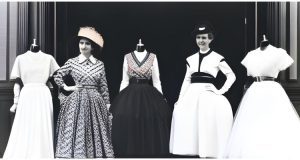Our lives have always revolved around fashion, which expresses our personalities as well as the sociological and cultural shifts occurring around us. The development of 20th Century Fashion serves as proof of the ongoing effect of historical, cultural, and political events on fashion. From the flapper dresses of the Roaring Twenties to the power dressing of the 1980s and the grunge and minimalism of the 1990s, the dominant fashion trends of each century revealed the tremendous changes in fashion that reflected societal developments.
Each time period had its own unique style and sources of inspiration, yet they all contributed to the development of contemporary clothing as we know it today. This article explores the development of 20th-century fashion in further detail, looking at how it changed from flappers through hip-hop and beyond.

I. The Roaring Twenties: The Age of Flappers
The 1920s, commonly referred to as the “Roaring Twenties,” were a period of profound societal, political, and cultural transformation that had a profound effect on fashion. The flapper, which symbolized the emergence of the modern, autonomous woman, was the most recognizable fashion of the day. While they were renowned for their disobedience, flappers were frequently viewed as a symbol of freedom and emancipation.
Short bob haircuts, short hemlines, and looser, more comfortable clothes were the hallmarks of flapper style. Corsets and other constrictive clothing were abandoned by women in favor of a newfound sense of freedom in their wardrobe choices. They were dressed comfortably and easily moved in drop-waist dresses made of breathable materials. The flappers’ attire was embellished with headbands, long beaded necklaces, and other accessories that gave it a glamorous finish.
The flapper era was significantly influenced by World War I. Because they had to labor outside the home to help with the war effort, women’s fashion preferences changed. Women’s attire started to reflect this as usefulness and practicality gained importance. After the war, women had more freedom and a desire to express themselves via their wardrobe choices. Flapper clothing was greatly influenced by the popularity of jazz music and dancing because ladies wanted to be able to move freely on the dance floor.
II. The Great Depression and World War II
Fashion suffered significantly during the 1930s period of economic downturn and misery. Consumers needed to make more sensible and cost-effective fashion decisions, and designers needed to adjust to the changing economic climate.
Due to the fact that individuals could not afford to purchase new clothing frequently during the Great Depression, clothing was made to be sturdy and long-lasting. Less focus was placed on grandeur and more on functionality as clothing grew simpler and more utilitarian. When utility clothing first emerged, it was composed of sturdy fabrics and had an adaptable, multipurpose design. Women’s gowns, for instance, included removable collars and cuffs that let them to be worn to both daytime and nighttime functions.
With many designers attempting to create functional apparel for women who were working in factories and other positions to help the war effort, World War II had a profound effect on fashion. Women’s clothes needed to be cozy, simple to put on and take off, and made to resist the abrasions of hard work.
Christian Dior’s “New Look” changed women’s fashion after the war as the fashion industry started to revive. The boxy and functional clothes of the postwar era were significantly changed by the hourglass form, voluminous skirt, and nipped-in waist that marked the New Look. The New Look signaled the start of a new era in fashion and a return to extravagance and luxury.
III. The 1960s: The Era of Youth Culture
The 1960s saw the significant social and political change, which was reflected in the time’s fashion. When the baby boomer generation reached adulthood, youth culture proliferated and influenced the fashion industry as well as popular culture as a whole.
The introduction of the miniskirt was one of the 1960s’ most important fashion trends. The lower hemline known as the miniskirt, which was created by British fashion designer Mary Quant, is frequently credited with revolutionizing women’s clothing. The shifting ideas regarding women’s positions in society were mirrored by the tiny skirt, which was considered as a sign of emancipation and freedom.
Moreover, designers experimented with unusual textiles and shapes during the 1960s. It became fashionable to wear psychedelic designs, vivid colors, and odd materials like PVC and vinyl. This was also the time when mod fashion first appeared, which was distinguished by its crisp lines and striking graphic patterns. The Beatles also had a big influence on fashion, especially men’s fashion, with their distinctive suits and mop-top haircuts.
Civil rights activity took place during the 1960s, and this was reflected in the fashion of the time. African American designers started to appear, such as Stephen Burrows and Patrick Kelly, whose creations included vivid colors, striking patterns, and an air of optimism and freedom.
IV. The 1970s: The Era of Disco
The music and clothing of the 1970s mirrored the social and cultural changes that characterized that age of transformation. The advent of disco, a music and dance style that significantly influenced fashion, was one of the most important movements of that decade.
Bright colors, sequins, and metallic textiles made up disco fashion. Deep necklines and exposed backs were frequent features of form-fitting clothing. Also fashionable were jumpsuits, platform heels, and bell bottoms. Both men’s and women’s attire might be considered as being influenced by disco, with both sexes adopting bright colors and flamboyant accessories.
The feminist and women’s liberation movements of the 1970s were also reflected in the decade’s fashion. Women’s attire loosened and grew more comfortable, with pantsuits and jumpsuits taking over as preferred attire in place of dresses and skirts. This was also the time when the “hippie” look first appeared, which was defined by long, flowing skirts and organic materials.
In the 1970s, the punk movement started to take off, led by fashion icons like Vivienne Westwood and Malcolm McLaren. Safety pins, shredded clothes, and a DIY style were hallmarks of punk fashion, which stood in opposition to prevailing trends in both fashion and society.

V. The 1980s: The Era of Power Dressing
The 1980s were a decade of excess, characterized by a heightened sense of confidence, economic expansion, and technical achievements. Bold colors, exaggerated shapes, and a concentration on power dressing were characteristics of 1980s fashion.
Throughout the 1980s, power dressing was a notable fashion trend that was typified by the attire that exuded confidence and prosperity. The advent of the working woman had a special impact on women’s fashion, and clothing was made to be strong and practical. In the office, women often wore the “power suit,” which consisted of a fitted jacket and skirt or trousers.
Designers like Thierry Mugler and Claude Montana created exaggerated designs highlighting large shoulders and a commanding presence, while shoulder pads were another distinguishing element of 1980s clothing. Huge hair, vibrant makeup, and statement jewelry were also in style, with massive necklaces and earrings becoming must-have accessories.
Punk, new wave, and hip-hop were three subcultures that had a big effect on fashion in the 1980s. With designers like Vivienne Westwood and Jean-Paul Gaultier adding punk themes to their creations, punk fashion continued to develop. The new wave movement, known for its vivid colors and futuristic designs, had a big impact on fashion in the 1980s as well.
VI. The 1990s: The Era of Grunge and Minimalism
Grunge and minimalism both had a big effect on the fashion world in the 1990s, which was a decade of contradictory trends. Rejecting popular fashion and putting an emphasis on uniqueness were characteristics of the grunge movement, which had its roots in Seattle’s music industry.
Flannel shirts, tattered jeans, and oversized apparel were the hallmarks of grunge fashion. The appearance was purposefully unkempt and unpolished, putting more of an emphasis on comfort and utility than on elegance. Music also saw a tremendous effect from the grunge movement, with artists like Nirvana and Pearl Jam setting the bar.
Meanwhile, minimalism was also rising in acceptance, led by fashion houses like Calvin Klein and Jil Sander. Clean lines, neutral hues, and an emphasis on simplicity were hallmarks of minimalist fashion. With boxy shapes, an emphasis on high-quality fabrics, and an often androgynous aesthetic, the style was popular.
The 1990s saw a considerable influence of hip-hop culture on fashion as well, with labels like FUBU and Tommy Hilfiger becoming more well-known. Hip-effect hop on both men’s and women’s fashion may be seen in the rise of athletic wear, baggy apparel, and large coats.
The 1990s saw the advent of new materials and industrial techniques, which had an influence on fashion as well. With the popularity of synthetic textiles and high-tech materials like Gore-Tex and Lycra, clothes became more practical and adaptable.
VII. Conclusion
With boxy shapes, an emphasis on high-quality fabrics, and an often androgynous aesthetic, the style was popular.
Hip-hop culture had a significant impact on fashion throughout the 1990s when brands like FUBU and Tommy Hilfiger gained popularity. Hip-effect hop in both men’s and women’s fashion may be seen in the rise of athletic wear, baggy apparel, and large coats.
New industrial methods and materials came into use in the 1990s, which had an impact on fashion as well. With the popularity of synthetic textiles and high-tech materials like Gore-Tex and Lycra, clothes became more practical and adaptable.
With the development of the hippie movement and the growth of mod fashion, the 1960s witnessed a new wave of young culture. Disco fashion emerged in the 1970s when bright designs and glitter were in vogue. Shoulder pads and huge hair were distinctive elements of the 1980s’ excess and power dressing.
Grunge and minimalist fashions were in contrast in the 1990s, with hip-hop culture also having a big influence. New materials and manufacturing techniques brought about by technology also had an impact on how clothing was created.
Overall, fashion has always served as a window into society and culture, with each decade ushering in its own aesthetic and set of vogue. From the flappers to hip-hop, fashion has been an important part of cultural expression and self-identity, and it will continue to evolve and change in the years to come.
